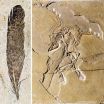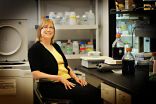(Press-News.org) For years, a multidisciplinary team of Johns Hopkins researchers has tracked an elusive creature, a complex of proteins thought to be at fault in some cases of sudden cardiac death. As they report Nov. 5 in the online edition of Nature Communications, they have finally captured images of the complex. Those images reveal the connection between some genetic mutations and electrical abnormalities of the heart and provide a starting point for designing therapies.
Sudden cardiac death is often caused by conditions that affect electrical signaling in the heart. Genetic studies have linked two of these conditions — long QT syndrome and Brugada syndrome — to mutations in the sodium channels that let sodium ions into cells in response to electrical signals. Many of the mutations affect a particular part of the channel that was thought to interact with a protein called calmodulin. This seemed important, because, explains Gordon Tomaselli, M.D., the Michel Mirowski, M.D., Professor of Cardiology at the Johns Hopkins University School of Medicine, "Calmodulin is the most ubiquitous calcium-binding protein in nature, and it regulates the function of sodium channels not only in the heart, but also in the brain and muscle."
The genetic studies were a hint that many cases of sudden cardiac death might come down to faulty interactions between sodium channels and calmodulin, which in turn would lead to electrical misfires. In that case, perhaps a drug could be designed that would correct the interaction. But finding such a drug would be a shot in the dark unless researchers could figure out what the sodium channel-calmodulin complex looked like — and how the mutations were affecting it.
Tomaselli's research group teamed with those of L. Mario Amzel, Ph.D., a professor of biophysics and biophysical chemistry, and Sandra Gabelli, Ph.D., an assistant professor of medicine and of biophysics and biophysical chemistry, to try to figure out the structure of the complex and how changes to it affect muscles' electrical properties. To learn that, the researchers had to coax bacterial cells to make human versions of sodium channel proteins and calmodulin, purify the protein complexes, and image them with a technique called X-ray crystallography. "We observed that binding to calmodulin changes the state of the sodium channel, leaving it poised to be activated, or opened, by an electrical signal from outside the cell," Gabelli says.
Previous studies had hinted that poised-for-activation sodium channels tended to be bound not just to calmodulin, but also to a second sodium channel. "As expected, we found that two sodium channels often bind both to each other and to calmodulin," Amzel says. "We were completely surprised, though, to find that it is the same domain of the two channels that interact with each other."
The researchers also tested the electrical properties of cells with normal and mutated versions of the sodium channel-calmodulin complex. They found that the latter corresponded with EKG readings of people with long QT and Brugada syndromes.
"Altering calmodulin regulation of sodium channels may be an important and novel therapeutic strategy for the treatment of heart failure, arrhythmias, neurological disorders, such as seizures and autism, and diseases of skeletal muscle," Tomaselli says.
INFORMATION:
Other authors on the paper are Agedi Boto, Victoria Halperin Kuhns, Mario A. Bianchet, Federica Farinelli, Srinivas Aripirala and Jesse Yoder, all of The Johns Hopkins University, and Jean Jakoncic of Brookhaven National Laboratory.
This study was funded by the National Heart, Lung and Blood Institute (grant number HL050411).
Related stories:
Structure Discovered for Promising Tuberculosis Drug Target
Salt Shakedown
Getting to the heart of the heart
Researchers capture images of a protein complex that keeps hearts beating
2014-11-05
ELSE PRESS RELEASES FROM THIS DATE:
Taking a deeper look at 'ancient wing'
2014-11-05
Berlin, Germany (November, 2014) – Reconstructing ancient life has long required a certain degree of imagination. This is especially true when considering the coloration of long-extinct organisms. However, new methods of investigation are being incorporated into paleontology that may shed light (and color) on fossils. Research presented at the recent Society of Vertebrate Paleontology meeting shows the importance of using new imaging technologies in reconstructing the color of Archaeopteryx, one of the most famous and important fossils species.
Ryan Carney of Brown ...
African diamond mine reveals dinosaur and large mammal tracks
2014-11-05
Berlin, Germany (November, 2014) – Unexpectedly one of the largest diamond mines in Africa, Catoca in Angola, holds 118 million year old dinosaur, crocodile and large mammal tracks. The mammal tracks show a raccoon-sized animal, during a time when most were no larger than a rat.
Nearly 70 distinct tracks were recovered in the Catoca mine in Angola. All the tracks were found in a small sedimentary basin, formed about 118 Ma, during the Early Cretaceous, in the crater of a kimberlite pipe.
The most important of these finds are those whose morphology is attributable ...
Jet-fueled electricity at room temperature
2014-11-05
SALT LAKE CITY, Nov. 5, 2014 – University of Utah engineers developed the first room-temperature fuel cell that uses enzymes to help jet fuel produce electricity without needing to ignite the fuel. These new fuel cells can be used to power portable electronics, off-grid power and sensors.
A study of the new cells appears online today in the American Chemical Society journal ACS Catalysis.
Fuel cells convert energy into electricity through a chemical reaction between a fuel and an oxygen-rich source such as air. If a continuous flow of fuel is provided, a fuel ...
Turning pretty penstemon flowers from blue to red
2014-11-05
While roses are red, and violets are blue, how exactly do flower colors change?
In the case of penstemons, with over 200 species to choose from, scientists Carolyn Wessinger and Mark Rausher have now shown that turning their flowers from blue to red involves knocking out the activity of just a single enzyme involved in the production of blue floral pigments.
A genetically conserved biochemical pathway produces the vivid blue pigments that they found to mutate over time to produce red. To shift into red pigment production, the enzyme flavonoid 3', 5' –hydroxylase ...
Patients with emergency-diagnosed lung cancer report barriers to seeing their GP
2014-11-05
MANY patients whose lung cancer is diagnosed as an emergency in hospital reported difficulties in previously seeing their GP, according to research presented at the National Cancer Research Institute (NCRI) Cancer Conference in Liverpool today (Tuesday).
The study, carried out by researchers from the London Cancer Alliance (LCA) and King's College London, investigated around 130 patients who were diagnosed with lung cancer after attending as an emergency at one of seven hospitals in south and west London.
Overall, nearly half of the patients reported that something ...
Scientists uncover potential drug to tackle 'undruggable' fault in third of cancers
2014-11-05
SCIENTISTS have found a possible way to halt one of the most common faults in many types of cancer, according to research presented at the National Cancer Research Institute (NCRI) Cancer Conference in Liverpool today (Wednesday).
A team of scientists at the Max Planck Institute of Molecular Physiology in Germany has
uncovered a new strategy and new potential drug to target an important signalling protein in cells called Ras, which is faulty in a third of cancers.
When the Ras protein travels from the centre of a cell to the cell membrane, it becomes 'switched on' ...
Trial results reveal first targeted treatment to boost survival for oesophageal cancer
2014-11-05
PATIENTS with a specific type of oesophageal cancer survived longer when they were given the latest lung cancer drug, according to trial results being presented at the National Cancer Research Institute (NCRI) Cancer Conference today (Wednesday).
Up to one in six patients with oesophageal cancer were found to have EGFR duplication in their tumour cells and taking the drug gefitinib, which targets this fault, boosted their survival by up to six months, and sometimes beyond.
This is the first treatment for advanced oesophageal cancer shown to improve survival in patients ...
Gene 'switches' could predict when breast cancers will spread to the brain
2014-11-05
SCIENTISTS have found a pattern of genetic 'switches' – chemical marks that turn genes on or off - that are linked to breast cancer's spread to the brain, according to research* presented at the National Cancer Research Institute Cancer Conference in Liverpool today (Wednesday).
The researchers, based at the University of Wolverhampton, studied 24 breast cancers that had spread to the brain, along with samples from the original breast tumour, and found a handful of genes with faulty switches.
Crucially, two of the genetic switches became faulty early on in the ...
New insight into the neuroscience of choking under pressure
2014-11-05
Everyone knows the scene: a basketball player at the free throw line, bouncing the ball as he concentrates on the basket. It's a tight game, and his team needs this point. He regularly makes baskets from much farther away while avoiding defenders, but now, when all is calm, he chokes and misses the basket, and his team loses. Recent research from The Johns Hopkins University suggests that in situations like this, performance depends on two factors: the framing of the incentive in terms of a loss or a gain, and a person's aversion to loss.
"We can measure someone's loss ...
Oxytocin levels in blood, cerebrospinal fluid are linked, Stanford study finds
2014-11-04
For years, scientists have debated how best to assess brain levels of oxytocin, a hormone implicated in social behaviors. Now, researchers at the Stanford University School of Medicine have found the first direct evidence in children that blood oxytocin measurements are tightly linked to levels of oxytocin in cerebrospinal fluid, which bathes the brain.
Low oxytocin levels in blood and CSF are both correlated to high anxiety levels, the research also showed. The findings will be published online Nov. 4 in Molecular Psychiatry.
"So many psychiatric disorders involve ...
LAST 30 PRESS RELEASES:
Making lighter work of calculating fluid and heat flow
Normalizing blood sugar can halve heart attack risk
Lowering blood sugar cuts heart attack risk in people with prediabetes
Study links genetic variants to risk of blinding eye disease in premature infants
Non-opioid ‘pain sponge’ therapy halts cartilage degeneration and relieves chronic pain
AI can pick up cultural values by mimicking how kids learn
China’s ecological redlines offer fast track to 30 x 30 global conservation goal
Invisible indoor threats: emerging household contaminants and their growing risks to human health
Adding antibody treatment to chemo boosts outcomes for children with rare cancer
Germline pathogenic variants among women without a history of breast cancer
Tanning beds triple melanoma risk, potentially causing broad DNA damage
Unique bond identified as key to viral infection speed
Indoor tanning makes youthful skin much older on a genetic level
Mouse model sheds new light on the causes and potential solutions to human GI problems linked to muscular dystrophy
The Journal of Nuclear Medicine ahead-of-print tip sheet: December 12, 2025
Smarter tools for peering into the microscopic world
Applications open for funding to conduct research in the Kinsey Institute archives
Global measure underestimates the severity of food insecurity
Child survivors of critical illness are missing out on timely follow up care
Risk-based vs annual breast cancer screening / the WISDOM randomized clinical trial
University of Toronto launches Electric Vehicle Innovation Ontario to accelerate advanced EV technologies and build Canada’s innovation advantage
Early relapse predicts poor outcomes in aggressive blood cancer
American College of Lifestyle Medicine applauds two CMS models aligned with lifestyle medicine practice and reimbursement
Clinical trial finds cannabis use not a barrier to quitting nicotine vaping
Supplemental nutrition assistance program policies and food insecurity
Switching immune cells to “night mode” could limit damage after a heart attack, study suggests
URI-based Global RIghts Project report spotlights continued troubling trends in worldwide inhumane treatment
Neutrophils are less aggressive at night, explaining why nighttime heart attacks cause less damage than daytime events
Menopausal hormone therapy may not pose breast cancer risk for women with BRCA mutations
Mobile health tool may improve quality of life for adolescent and young adult breast cancer survivors
[Press-News.org] Getting to the heart of the heartResearchers capture images of a protein complex that keeps hearts beating



